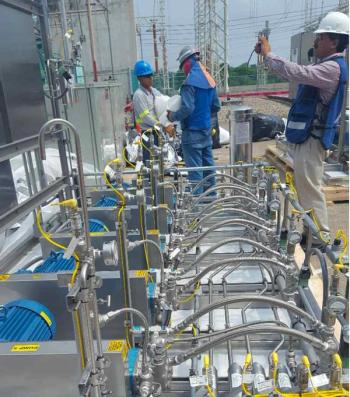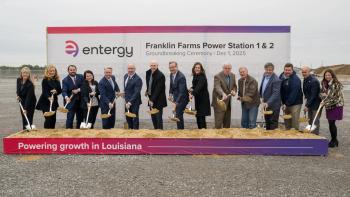
FUEL SWITCHING
GAS TURBINES RUNNING ON HYDROGEN OR A NATURAL GAS AND HYDROGEN MIXTURE COULD AID IN EMISSIONS REDUCTION
By Drew Robb
For many years, natural gas has been looked upon as the benign fossil fuel, offering far lower emissions than oil or coal. Its place had been established in a clean, or at least, cleaner energy future.
That began to change about a decade ago when natural gas was thought of as a “bridging technology” between polluting fuels sources and renewable energy. Once that bridge was crossed, natural gas-fueled technologies would be phased out, much like coal plants.
Today, national and international energy regulators are mandating that utilities purchase and install renewable power resources. This policy shift to carbon neutrality — achieving net zero carbon emissions — has moved natural gas from the “benign” to the “menace” category, in the eyes of some. Others, however, understand the necessities of the grid and see a role in it for the gas turbine (GT).
Companies, such as Siemens, GE, Mitsubishi Hitachi Power Systems (MHPS) and Ansaldo Thomassen, are actively working on fuel gas mixtures of natural gas and hydrogen that can lower and ultimately eliminate carbon emissions from turbomachinery. They are also developing machines that, one day, may even function on 100% hydrogen.
The promise of hydrogen
Hydrogen fuel offers many advantages in energy production. It is a carbon-free fuel that can decarbonize power and heat generation, and transportation, to help meet long-term CO2 emission-reduction targets. Burning hydrogen produces no CO2 emissions.
NOx emissions are a different matter. The more hydrogen is added to a natural gas and hydrogen combustion mixture, the higher NOx rises. Adding diluent gases, such as nitrogen and steam, however, has been shown to bring NOx down to single-digit levels.
Several sources of hydrogen are being studied. It can be generated from natural gas by steam reforming. Biomass can also be subjected to steam reforming or gasification to produce hydrogen. And hydrogen can be generated via electrolysis from excess renewable energy.
“One route towards a hydrogen economy is to combine renewable power generation with electrolysis and long-term or short-term storage,” said Michael Welch, Industry Marketing Manager, Power and Gas Division, Siemens. “The idea is to use ‘surplus’ renewable electricity to create hydrogen that can be used to generate zero-carbon electricity at times when renewable power generation volumes are low.”
Most hydrogen today is generated from natural gas, using steam methane reforming. Generating enough hydrogen for large-scale power generation via electrolysis or gasification will require tremendous volumes of feedstock (i.e., water or biomass), said Dr. Jeffrey Goldmeer, Director, Gas Turbine Combustion & Fuels Solutions for Gas Power Systems at GE Power.
“Although is it technically feasible to generate hydrogen via reforming natural gas, electrolysis of water, or gasification, they all require significant improvements in technology to raise overall efficiency and reduce cost,” said Goldmeer. “Or they require a change in regulations to be economically viable.”
If hydrogen production can be solved viably, it could potentially be transported over existing pipeline networks, ships or trucks. It could also be stored in liquid form in tanks in a mixture with ammonia and other organic substances. Some envision pressurized hydrogen being stored in salt caverns.
Hydrogen has one-third the heating value (on a volumetric basis) relative to methane, thus requiring roughly three times more fuel flow to the gas turbine. Hydrogen is a smaller molecule than methane, so mechanical seals configured for methane may not seal against hydrogen creating potential fuel leakage. In addition, the flame speed of hydrogen is ~10x that of other hydrocarbons.
Overcoming the hurdles
OEM research on the use of hydrogen fuel in gas turbines has been an ongoing effort, as illustrated below. But it is not without its technical hurdles, such as avoiding auto ignition in the fuel premix zone and flashback, in which the flame moves from its desired position in the combustion can back towards the fuel injectors.
Blending spools for fuel switching
MHPS
MHPS has almost five decades of experience in the deployment of hydrogen in various forms in gas turbines. Some 31 units have been running on syngas, refinery gas, coke oven gas (COG), and blast furnace gas (BFG). Many of them use a diffusion-type combustor which typically requires water or steam injection.
Currently, MHPS is refining its existing natural gas-fired combustors to cope with a larger volume of hydrogen. Its Dry Low NOx (DLN) combustor has traditionally mixed the fuel with sufficient air in advance of the combustor, so burning can take place in a lean atmosphere to maintain a relatively cool flame and keep NOx down.
That approach does not work so well when more hydrogen enters the picture due to auto ignition occurring in the premix zone. As a result, the combustor is being modified at the MHPS Takasago Works facility in Japan to achieve a mix of hydrogen and natural gas that could be used in large-frame GTs.
The company already has diffusion-type combustor technology where fuel and air are supplied separately. Hydrogen, though, burns with a hotter flame, leading to higher combustion temperatures and the formation of local hot spots. These, in turn, can cause NOx to increase. The solution is to cool the flame by use of diluents, such as demineralized water, steam or nitrogen. As well as reducing NOx, this also reduces efficiency compared to a DLN combustor.
Those findings were the driver for the development of the multi-cluster diffusion burner to protect against flashback. Each nozzle can mix air and hydrogen. This means a smaller diffusion flame, faster and better mixing, a lower overall combustion temperature, and lower NOx.
Work on this project is in the early stages. The new combustor has been tested on a small gas turbine using Liquefied Petroleum Gas (LPG). It calls for replacement of the fuel nozzle, combustor basket, transition piece, ignitors and flame detectors. Fuel lines must also be augmented to cope with a larger fuel flow.
MHPS wants to retrofit this technology into existing GTs. However, the attainment of a combustor running in a gas turbine on 100% hydrogen is not targeted for commercial operation until 2030. In the meantime, the company has successfully completed a firing test with 30% hydrogen using DLN technology at 1,600°C. This resulted in CO2 emissions 10% lower than those running only on natural gas.
Siemens
Siemens’ interest in fuel switching stems from a desire to make use of “opportunity fuels” to reduce operational costs. Opportunity fuels, some with high hydrogen content, are typically process off-gases, such as refinery gas or coke over gas that would otherwise have been flared or used in low-efficiency energy production processes.
Siemens is addressing several challenges facing hydrogen-enabled turbomachinery: getting the fuel into the combustors safely, burning it stably and reliably, and controlling the combustion emissions.
“With a higher flame temperature than natural gas, NOx emissions will be higher with hydrogen as the fuel source if no additional measures are taken,” said Welch. “But as hydrogen is not a new fuel, the safety record of gas turbines on high-hydrogen fuels is excellent.”
Siemens research on high-hydrogen fuels is moving away from diffusion flame combustion systems to DLN combustion. It seeks to mitigate flashback risk and combustion instabilities. According to Welch, reducing NOx while maintaining combustion stability without needing “wet” NOx reduction methods or SCRs is a big challenge going forward.
At low levels of hydrogen (up to 20% by volume), no changes to the fuel system or combustors are required, according to Siemens. At higher levels, material selection and sizing of the fuel system needs to be considered, and care must be taken in the combustion system design and operation to avoid flashback. Siemens is incorporating 3D printed components into fuel injector design to ensure safe operation with hydrogen.
“The mixing of natural gas and hydrogen should be undertaken before the fuel mixture reaches the turbine itself,” said Welch. “If this is done, then the fuel system and combustion system can be optimized for the potential range of hydrogen concentrations expected.”
Siemens has hydrogen capability at various levels across its GT portfolio from 4 MW to 567 MW. It also has decades of experience of operation on high-hydrogen fuels. Most recently, progress has been made on enhancing the hydrogen capabilities of its DLE combustion systems. Its SGT-600, -700 and -800 GTs (24 MW to 57 MW) offer up to 60% hydrogen in natural gas on a volume basis with NOx emission levels as low as 25 ppm.
Due to the combustion characteristics of hydrogen, there are limits on the allowable concentrations in current premixed combustion systems, said Welch. The limits on hydrogen concentration are set to ensure stable and safe operation with regard gas turbine operability, i.e., undesired flame propagation and combustion dynamics outside of a preferred range. Today, operation on 100% hydrogen requires the use of a diffusion flame combustor, which avoids mixing of fuel and air upstream of the reaction zone.
“We are currently working on a capability-expansion project to enable the burners to be able to operate on up to 100% hydrogen as a fuel,” said Welch.
GE’s High hydrogen-fueled 6B gas turbine in South Korea[/caption]
GE
GE’s experience with hydrogen-containing fuels, includes its aeroderivatives, E- and F-class GTs operating in steel mill plants, integrated gasification combined cycle (IGCC) power plants, refineries, and petrochemical plants with waste or process gases containing hydrogen.
As part of the U.S. Department of Energy High Hydrogen Turbine Program, GE has developed a premixed combustor capable of operating on high-hydrogen fuels. This combustor, called the DLN 2.6e, is now shipping on 9HA gas turbines. Based on preliminary lab testing, this combustor is capable of operating on a natural gas blend with about 50% hydrogen (by volume).
GE offers upgrade packages, so its gas turbines can run on fuels beyond their initial configuration. “This may aid in providing financial security for the plant owner or operator; and may also aid in providing energy security for the electrical utilities, since gas turbines can be re-configured to consume other fuels as situations require,” said Goldmeer. “The ability to switch fuels may prevent the operator from being locked into a fuel prone to major price increases or unavailability.”
When switching fuels, it is important to consider their physical and combustion characteristics and the impact to GT systems and operability. “Combined, these differences create an increased potential for fuel nozzle distress,” said Goldmeer. “Once the differences in the fuels are defined, the current fuel and combustion configuration for a specific site can be evaluated to define the required changes to switch fuels.”
Example of a hydrogen fuel conversion retrofit
Ansaldo
Ansaldo Thomassen (AT) is Ansaldo Energia’s service team for non-Ansaldo GTs. It comprises PSM, Ansaldo Thomassen and Ansaldo Thomassen Gulf. AT is working on combustion technology for fuel mixing and greater hydrogen content.
Dr. Peter Stuttaford, AT’s CEO, agrees that the high flame speed of hydrogen used in DLN systems is a challenge due to flashback margin reduction, NOx increase and shifting flame position potentially overheating components.
“Fuel skid and controls require special attention to avoid leakage and safe turbine control,” he said. “However, these items can be solved with the right system design.”
Rapid premixing, independent of Wobbe index variation, is needed, said Stuttaford. High premixer exit velocities can provide the needed flashback margin, with careful treatment of boundary layer shear and the fuel-air ratio.
It is also necessary to provide a strong flame stabilization mechanism that does not shift substantially with fuel reactivity. AT’s LEC combustor is available for up to 25% hydrogen. Its Flamesheet combustor can tackle up to 40% hydrogen.
“Tests are ongoing to demonstrate 80% hydrogen capability for Flamesheet, and development work is ongoing for a 100% hydrogen demonstration,” said Stuttaford.
Newsletter
Power your knowledge with the latest in turbine technology, engineering advances, and energy solutions—subscribe to Turbomachinery International today.





